Deck 5: Matter Behaves Like Waves Quantum Physics
Question
Question
Question
Question
Question
Question
Question
Question
Question
Question
Question
Question
Question
Question
Question
Question
Question
Question
Question
Question
Question
Question
Question
Question
Question
Question
Question
Question
Question
Question
Question
Question
Question
Question
Question
Question
Question
Question
Question
Question
Question
Question
Question
Question
Question
Question
Question
Question
Question
Question
Question
Question
Question
Question
Question
Question
Question
Question
Question
Question
Question
Question
Question
Question
Question
Question
Question
Question
Question
Question
Question
Question
Question
Question
Question
Question
Question
Question
Question
Question

Unlock Deck
Sign up to unlock the cards in this deck!
Unlock Deck
Unlock Deck
1/210
Play
Full screen (f)
Deck 5: Matter Behaves Like Waves Quantum Physics
1
As one approaches the bottom of a body of water, the circles shown in figure Q1.3 for water waves moving along the water's surface become increasingly vertically flattened ellipses. This means that the waves near the body's bottom are more (A) transverse or (B) longitudinal than those near the surface?
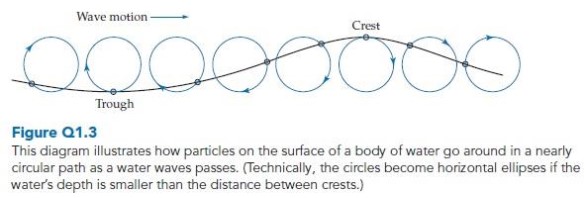
A) Transverse
B) Longitudinal

A) Transverse
B) Longitudinal
Longitudinal
2
Imagine a series of mutually repelling ring magnets strung along a nearly frictionless horizontal rigid rod. If one jostles a magnet near one end of the rod, it can cause a wave of disturbance to move down the rod through the other magnets. Will this be a (A) transverse or (B) longitudinal wave?
A) Transverse wave
B) Longitudinal wave
A) Transverse wave
B) Longitudinal wave
Longitudinal wave
3
As a sinusoidal wave's wavenumber increases, the wave's wavelength (in a non-dispersive medium)
A) Increases.
B) Decreases.
C) Does not change.
A) Increases.
B) Decreases.
C) Does not change.
Decreases.
4
A sinusoidal wave's angular frequency is (A) larger, (B) smaller, or (C) the same as its frequency in cycles/s.
A) Large
B) Smaller
C) The same as its frequency in cycles/s.
A) Large
B) Smaller
C) The same as its frequency in cycles/s.

Unlock Deck
Unlock for access to all 210 flashcards in this deck.
Unlock Deck
k this deck
5
Equation implies that a sinusoidal wave's phase speed depends on its wavelength.

Unlock Deck
Unlock for access to all 210 flashcards in this deck.
Unlock Deck
k this deck
6
Consider wiggle formula for a transverse wave, where and are constants and is some arbitrary function. Is this a traveling wave model? If so, in what direction does it travel?
A) In the direction.
B) In the direction.
C) The wave does not move.
D) In the or direction because the wave is transverse.
A) In the direction.
B) In the direction.
C) The wave does not move.
D) In the or direction because the wave is transverse.

Unlock Deck
Unlock for access to all 210 flashcards in this deck.
Unlock Deck
k this deck
7
In a specific non-dispersive medium, a sinusoidal wave's angular frequency is proportional to its wavenumber.

Unlock Deck
Unlock for access to all 210 flashcards in this deck.
Unlock Deck
k this deck
8
In a specific non-dispersive medium, a sinusoidal wave's period is proportional to its wavelength.

Unlock Deck
Unlock for access to all 210 flashcards in this deck.
Unlock Deck
k this deck
9
If one sound is louder than another sound, its intensity is
A) 2 times greater.
B) 20 times greater.
C) 100 times greater.
D) 200 times greater.
E) We need to know the actual sound level: to represents a different factor of intensity increase than 60 to (for example).
A) 2 times greater.
B) 20 times greater.
C) 100 times greater.
D) 200 times greater.
E) We need to know the actual sound level: to represents a different factor of intensity increase than 60 to (for example).

Unlock Deck
Unlock for access to all 210 flashcards in this deck.
Unlock Deck
k this deck
10
A linear traveling wave can be partially reflected when it encounters another linear traveling wave.

Unlock Deck
Unlock for access to all 210 flashcards in this deck.
Unlock Deck
k this deck
11
A sound wave traveling in air hits the surface of a body of water. Is the reflected wave (A) inverted or (B) upright? (Make a guess.)
A) Inverted
B) Upright
A) Inverted
B) Upright

Unlock Deck
Unlock for access to all 210 flashcards in this deck.
Unlock Deck
k this deck
12
A sound wave traveling in air hits the surface of a body of water. The reflection will be total.

Unlock Deck
Unlock for access to all 210 flashcards in this deck.
Unlock Deck
k this deck
13
Imagine that the wave shown below moves right along a stretched string. It meets and passes through one of the left-going waves provided in the choices. For which choice is there an instant where the string is flat?

A) A
B) B
C) C
D) D
E) None of the above

A) A
B) B
C) C
D) D
E) None of the above

Unlock Deck
Unlock for access to all 210 flashcards in this deck.
Unlock Deck
k this deck
14
Consider the right-going wave and the possible left-going waves displayed in problem Q2T.3. For which of the choices will there be an instant where the combined wave is a rectangular wave as shown below?
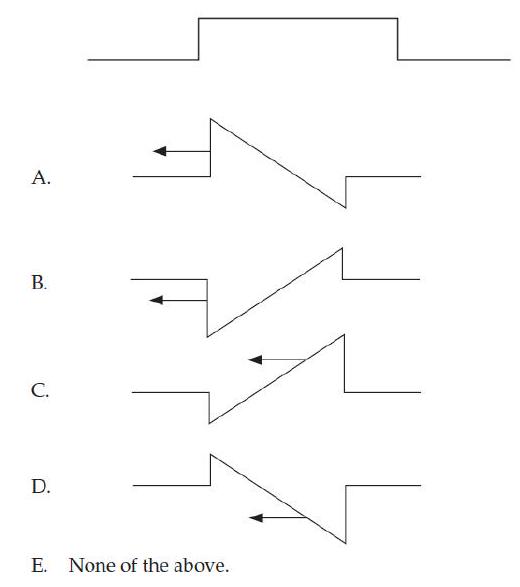
A) A
B) B
C) C
D) D
E) None of the above

A) A
B) B
C) C
D) D
E) None of the above

Unlock Deck
Unlock for access to all 210 flashcards in this deck.
Unlock Deck
k this deck
15
Suppose we create a traveling compression wave in a spring that has one end fixed. When the wave reflects from the fixed end, it will be inverted (that is, compression will become rarefaction and vice versa).

Unlock Deck
Unlock for access to all 210 flashcards in this deck.
Unlock Deck
k this deck
16
Suppose you are near one end of a 150-m-long cylindrical tunnel open to the air on both ends. If you give a shout, you might hear an echo.

Unlock Deck
Unlock for access to all 210 flashcards in this deck.
Unlock Deck
k this deck
17
If you face a cliff and give a shout, you will hear an echo. Are the sound waves of the echo inverted (A) or upright (B) compared to the waves of your original shout?
A) Inverted
B) Upright
A) Inverted
B) Upright

Unlock Deck
Unlock for access to all 210 flashcards in this deck.
Unlock Deck
k this deck
18
The frequencies of the normal modes of a string that is free at both ends are the same as those of a string that is fixed at both ends.

Unlock Deck
Unlock for access to all 210 flashcards in this deck.
Unlock Deck
k this deck
19
A sinusoidal standing sound wave inside a tube that is open at both ends must fit between the tube's ends
A) An integer number of wavelengths.
B) An integer number of half-wavelengths.
C) An integer number of quarter-wavelengths
D) An odd-integer number of half-wavelengths.
E) An odd-integer number of quarter-wavelengths.
A) An integer number of wavelengths.
B) An integer number of half-wavelengths.
C) An integer number of quarter-wavelengths
D) An odd-integer number of half-wavelengths.
E) An odd-integer number of quarter-wavelengths.

Unlock Deck
Unlock for access to all 210 flashcards in this deck.
Unlock Deck
k this deck
20
The normal mode of a resonating system is sinusoidally disturbed at a frequency . Assume that , where is the normal mode's natural frequency.
-(a) What is the amplitude of the normal mode's oscillation compared to its amplitude in the limit that the disturbance frequency goes to zero if is about ?
A) Roughly zero
B) Roughly
C) Roughly
D) Roughly
E) Roughly
F) Roughly
G) Other (specify)
-(a) What is the amplitude of the normal mode's oscillation compared to its amplitude in the limit that the disturbance frequency goes to zero if is about ?
A) Roughly zero
B) Roughly
C) Roughly
D) Roughly
E) Roughly
F) Roughly
G) Other (specify)

Unlock Deck
Unlock for access to all 210 flashcards in this deck.
Unlock Deck
k this deck
21
The normal mode of a resonating system is sinusoidally disturbed at a frequency . Assume that , where is the normal mode's natural frequency.
-(b) If is about ?
A) Roughly zero
B) Roughly
C) Roughly
D) Roughly
E) Roughly
F) Roughly
G) Other (specify)
-(b) If is about ?
A) Roughly zero
B) Roughly
C) Roughly
D) Roughly
E) Roughly
F) Roughly
G) Other (specify)

Unlock Deck
Unlock for access to all 210 flashcards in this deck.
Unlock Deck
k this deck
22
Two stretched strings with the same length but different tensions are both resonating at the same frequency. Which string has the greater number of antinodes?
A) The string with the larger tension.
B) The string with the smaller tension.
C) Both must have the same number of antinodes.
A) The string with the larger tension.
B) The string with the smaller tension.
C) Both must have the same number of antinodes.

Unlock Deck
Unlock for access to all 210 flashcards in this deck.
Unlock Deck
k this deck
23
In chapter Q1, we noted that the speed of sound in air depends on the air's temperature (increasing as the square root of the air temperature). Suppose a flute player tunes a flute that has been sitting in a cold automobile. As the flute warms up to room temperature, does it go sharp (A) or flat (B)?
A) Sharp
B) Flat
A) Sharp
B) Flat

Unlock Deck
Unlock for access to all 210 flashcards in this deck.
Unlock Deck
k this deck
24
The period of the fundamental mode of the air in a pipe open at one end and closed at the other is equal to what multiple or fraction of the time required for a sound wave to travel from one end of the tube to the other?
A)
B)
C)
D)
E)
A)
B)
C)
D)
E)

Unlock Deck
Unlock for access to all 210 flashcards in this deck.
Unlock Deck
k this deck
25
A certain organ pipe is open at both ends. Another pipe of the same length is open at one end and closed at the other. Which will have the lower pitch?
A) The pipe open at both ends.
B) The pipe closed at one end.
C) Both will have the same pitch.
D) It depends on the pipes' diameters.
A) The pipe open at both ends.
B) The pipe closed at one end.
C) Both will have the same pitch.
D) It depends on the pipes' diameters.

Unlock Deck
Unlock for access to all 210 flashcards in this deck.
Unlock Deck
k this deck
26
Waves from two slits and will destructively interfere and cancel at a point if the distance between and is larger than the distance between and by
A)
B) (where is an integer)
C) (where is an integer)
D) (where is an integer)
E) Other (specify)
A)
B) (where is an integer)
C) (where is an integer)
D) (where is an integer)
E) Other (specify)

Unlock Deck
Unlock for access to all 210 flashcards in this deck.
Unlock Deck
k this deck
27
Consider a two-slit interference experiment like the one shown in figure Q3.7b. The distance between adjacent bright spots in the interference pattern on the screen ,
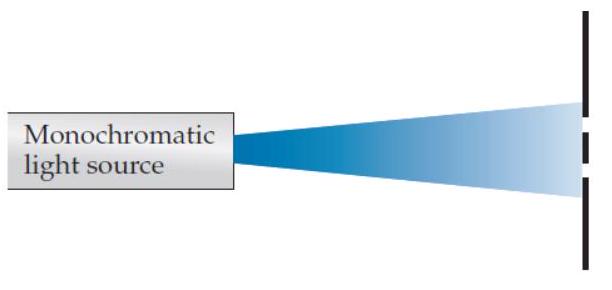
-The wavelength of the light increases.
A) increases
B) decreases
C) remains the same

-The wavelength of the light increases.
A) increases
B) decreases
C) remains the same

Unlock Deck
Unlock for access to all 210 flashcards in this deck.
Unlock Deck
k this deck
28
Consider a two-slit interference experiment like the one shown in figure Q3.7b. The distance between adjacent bright spots in the interference pattern on the screen ,

-The spacing between the slits increases.
A) increases
B) decreases
C) remains the same

-The spacing between the slits increases.
A) increases
B) decreases
C) remains the same

Unlock Deck
Unlock for access to all 210 flashcards in this deck.
Unlock Deck
k this deck
29
Consider a two-slit interference experiment like the one shown in figure Q3.7b. The distance between adjacent bright spots in the interference pattern on the screen ,

- The intensity of the light increases.
A) increases
B) decreases
C) remains the same

- The intensity of the light increases.
A) increases
B) decreases
C) remains the same

Unlock Deck
Unlock for access to all 210 flashcards in this deck.
Unlock Deck
k this deck
30
Consider a two-slit interference experiment like the one shown in figure Q3.7b. The distance between adjacent bright spots in the interference pattern on the screen ,

-The width of the slits increases.
A) increases
B) decreases
C) remains the same

-The width of the slits increases.
A) increases
B) decreases
C) remains the same

Unlock Deck
Unlock for access to all 210 flashcards in this deck.
Unlock Deck
k this deck
31
Consider a two-slit interference experiment like the one shown in figure Q3.7b. The distance between adjacent bright spots in the interference pattern on the screen ,

-The distance between the slits and the screen increases.
A) increases
B) decreases
C) remains the same

-The distance between the slits and the screen increases.
A) increases
B) decreases
C) remains the same

Unlock Deck
Unlock for access to all 210 flashcards in this deck.
Unlock Deck
k this deck
32
Consider a two-slit interference experiment like the one shown in figure Q3.7b. The distance between adjacent bright spots in the interference pattern on the screen ,

-The value of increases (careful!).
A) increases
B) decreases
C) remains the same

-The value of increases (careful!).
A) increases
B) decreases
C) remains the same

Unlock Deck
Unlock for access to all 210 flashcards in this deck.
Unlock Deck
k this deck
33
Imagine that sound waves with a certain definite wavelength flow through a partially open sliding door. If the door is closed somewhat further (but not shut entirely), the angle through which the sound waves are diffracted
A) Decreases.
B) Increases.
C) Remains the same.
D) Depends on quantities not specified (explain).
A) Decreases.
B) Increases.
C) Remains the same.
D) Depends on quantities not specified (explain).

Unlock Deck
Unlock for access to all 210 flashcards in this deck.
Unlock Deck
k this deck
34
Imagine that sound waves with a certain definite wavelength flow through a partially open sliding door. If the wavelength of the waves increases, the angle through which the sound waves are diffracted
A) Decreases.
B) Increases.
C) Remains the same.
D) Depends on quantities not specified (explain).
A) Decreases.
B) Increases.
C) Remains the same.
D) Depends on quantities not specified (explain).

Unlock Deck
Unlock for access to all 210 flashcards in this deck.
Unlock Deck
k this deck
35
Line waves with wavelength going through a slit with width a will be diffracted into circular waves with approximately equal amplitude in all forward directions
A) Always
B) Never
C) Only if
D) Only if
E) Only if
A) Always
B) Never
C) Only if
D) Only if
E) Only if

Unlock Deck
Unlock for access to all 210 flashcards in this deck.
Unlock Deck
k this deck
36
If the two slits in a two-slit interference experiment are so far apart that their diffraction patterns do not overlap, the pattern displayed is consistent with a particle model of light.

Unlock Deck
Unlock for access to all 210 flashcards in this deck.
Unlock Deck
k this deck
37
Consider an experiment where we send monochromatic light to a distant screen through a single narrow slit. The distance between adjacent dark fringes in the diffraction pattern displayed on the screen
- The wavelength of the light increases.
A) increases
B) decreases
C) remains the same
- The wavelength of the light increases.
A) increases
B) decreases
C) remains the same

Unlock Deck
Unlock for access to all 210 flashcards in this deck.
Unlock Deck
k this deck
38
Consider an experiment where we send monochromatic light to a distant screen through a single narrow slit. The distance between adjacent dark fringes in the diffraction pattern displayed on the screen
-The intensity of the light increases.
A) increases
B) decreases
C) remains the same
-The intensity of the light increases.
A) increases
B) decreases
C) remains the same

Unlock Deck
Unlock for access to all 210 flashcards in this deck.
Unlock Deck
k this deck
39
Consider an experiment where we send monochromatic light to a distant screen through a single narrow slit. The distance between adjacent dark fringes in the diffraction pattern displayed on the screen
-The width of the slit increases.
A) increases
B) decreases
C) remains the same
-The width of the slit increases.
A) increases
B) decreases
C) remains the same

Unlock Deck
Unlock for access to all 210 flashcards in this deck.
Unlock Deck
k this deck
40
Consider an experiment where we send monochromatic light to a distant screen through a single narrow slit. The distance between adjacent dark fringes in the diffraction pattern displayed on the screen
- The distance between the slit and the screen increases.
A) increases
B) decreases
C) remains the same
- The distance between the slit and the screen increases.
A) increases
B) decreases
C) remains the same

Unlock Deck
Unlock for access to all 210 flashcards in this deck.
Unlock Deck
k this deck
41
Consider an experiment where we send monochromatic light to a distant screen through a single narrow slit. The distance between adjacent dark fringes in the diffraction pattern displayed on the screen
-We look at fringes farther from the central maximum.
A) increases
B) decreases
C) remains the same
-We look at fringes farther from the central maximum.
A) increases
B) decreases
C) remains the same

Unlock Deck
Unlock for access to all 210 flashcards in this deck.
Unlock Deck
k this deck
42
In the region where their beams overlap, two car headlights will create a clear interference pattern on a distant screen.

Unlock Deck
Unlock for access to all 210 flashcards in this deck.
Unlock Deck
k this deck
43
If we shine white light through two slits onto a distant screen, we will see a clear interference pattern.

Unlock Deck
Unlock for access to all 210 flashcards in this deck.
Unlock Deck
k this deck
44
Imagine we have an adjustable slit that we can make wider or narrower. If we shine light of a fixed intensity on the slit, and then crank the slit so its width decreases (while keeping other things the same), will the light at the center of the central peak on the display screen?
A) Remain the same
B) Get brighter
C) Get dimmer
A) Remain the same
B) Get brighter
C) Get dimmer

Unlock Deck
Unlock for access to all 210 flashcards in this deck.
Unlock Deck
k this deck
45
Eagles and other predatory birds have very sharp eyesight. The pupil of an eagle's eye is roughly twice the size of a human's under similar (daylight) conditions. A friend claims to have read that an eagle's eye has 8 times the resolving power of a human eye in broad daylight. This is physically impossible.

Unlock Deck
Unlock for access to all 210 flashcards in this deck.
Unlock Deck
k this deck
46
With an optically perfect 200-power telescope with a 1.5-inch-diameter tube, you can resolve objects roughly how many times closer together than you could with your naked eye? (Choose the closest answer.)
A) 200 times
B) 100 times
C) 20 times
D) 5 times
E) No better at all
A) 200 times
B) 100 times
C) 20 times
D) 5 times
E) No better at all

Unlock Deck
Unlock for access to all 210 flashcards in this deck.
Unlock Deck
k this deck
47
Sunlight falling on a spaceship in a vacuum will cause the spaceship to become a bit positively charged.

Unlock Deck
Unlock for access to all 210 flashcards in this deck.
Unlock Deck
k this deck
48
In the apparatus shown in figure Q4.1a, the value displayed by the ammeter is proportional to

A) The rate at which electrons emerge from the cathode.
B) The average kinetic energy of the ejected electrons.
C) The maximum kinetic energy of the ejected electrons.
D) Both A and C.

A) The rate at which electrons emerge from the cathode.
B) The average kinetic energy of the ejected electrons.
C) The maximum kinetic energy of the ejected electrons.
D) Both A and C.

Unlock Deck
Unlock for access to all 210 flashcards in this deck.
Unlock Deck
k this deck
49
For experiments involving the setup shown in figure Q4.1a, which of the following possible results (if seen) about the value displayed by the ammeter would probably not be consistent with the wave model of light?

A) It is zero for some time after light starts shining.
B) It increases as the light's intensity increases.
C) It varies as the light's wavelength changes.
D) It is zero if the wavelength is larger than a certain value.

A) It is zero for some time after light starts shining.
B) It increases as the light's intensity increases.
C) It varies as the light's wavelength changes.
D) It is zero if the wavelength is larger than a certain value.

Unlock Deck
Unlock for access to all 210 flashcards in this deck.
Unlock Deck
k this deck
50
In the apparatus shown in figure Q4.1b, the final value displayed by the voltmeter is proportional to
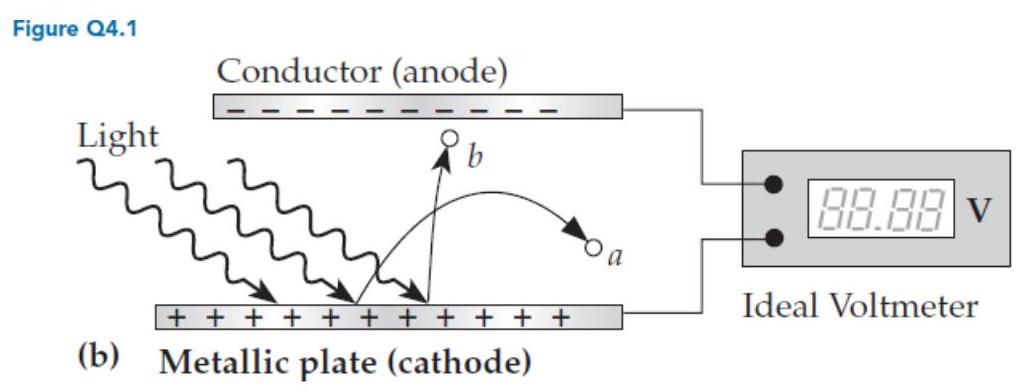
A) The rate at which electrons emerge from the cathode.
B) The average kinetic energy of the ejected electrons.
C) The maximum kinetic energy of the ejected electrons.
D) Both A and C.

A) The rate at which electrons emerge from the cathode.
B) The average kinetic energy of the ejected electrons.
C) The maximum kinetic energy of the ejected electrons.
D) Both A and C.

Unlock Deck
Unlock for access to all 210 flashcards in this deck.
Unlock Deck
k this deck
51
For experiments involving the setup shown in figure , which of the following possible results (if seen) regarding the final value displayed by the voltmeter would probably not be consistent with the wave model of light?
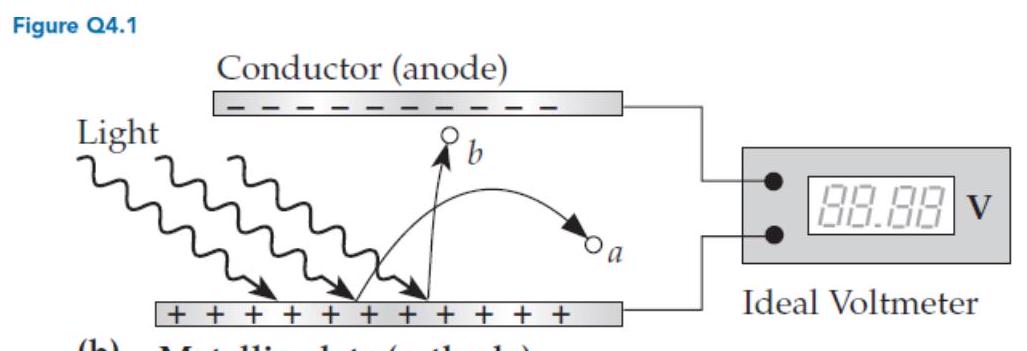
(b) Metallic plate (cathode)
A) It increases as the light's intensity increases.
B) It is independent of the light's intensity.
C) It varies as the light's wavelength changes.
D) It increases as the rate of electron ejection increases.

(b) Metallic plate (cathode)
A) It increases as the light's intensity increases.
B) It is independent of the light's intensity.
C) It varies as the light's wavelength changes.
D) It increases as the rate of electron ejection increases.

Unlock Deck
Unlock for access to all 210 flashcards in this deck.
Unlock Deck
k this deck
52
In experiments involving the setup shown in figure Q4.1b, the value that the voltmeter displays increases for a short period of time after light starts shining on the cathode, but then quickly settles down to a fixed value. Why?
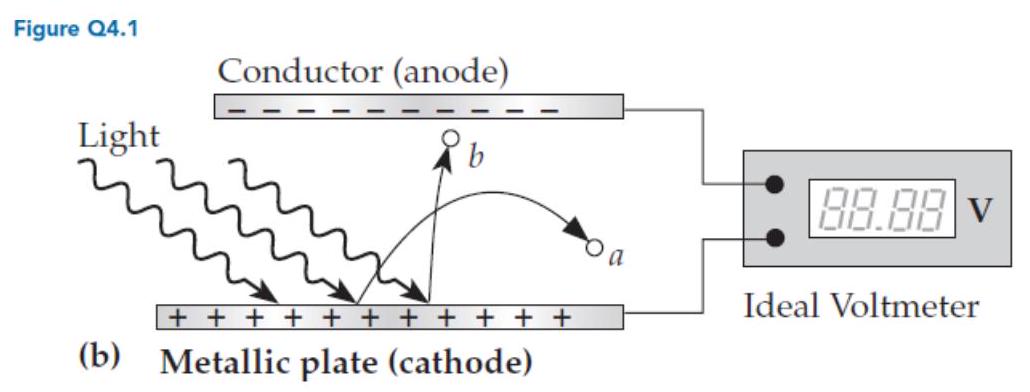
A) The cathode eventually stops emitting electrons.
B) The kinetic energy of ejected electrons starts out small but quickly reaches a maximum value.
C) The charge difference between the cathode and anode is initially small but with time becomes so large that no electron from the cathode can make it to the anode.
D) The cathode eventually runs out of electrons to emit.
E) Some other explanation (describe).

A) The cathode eventually stops emitting electrons.
B) The kinetic energy of ejected electrons starts out small but quickly reaches a maximum value.
C) The charge difference between the cathode and anode is initially small but with time becomes so large that no electron from the cathode can make it to the anode.
D) The cathode eventually runs out of electrons to emit.
E) Some other explanation (describe).

Unlock Deck
Unlock for access to all 210 flashcards in this deck.
Unlock Deck
k this deck
53
In an experiment involving the apparatus shown in figure Q4.1b, suppose that after shining light on the cathode long enough that the voltmeter settles down to a fixed value, we suddenly cut off the light. If the voltmeter is truly ideal, what happens to the value displayed?
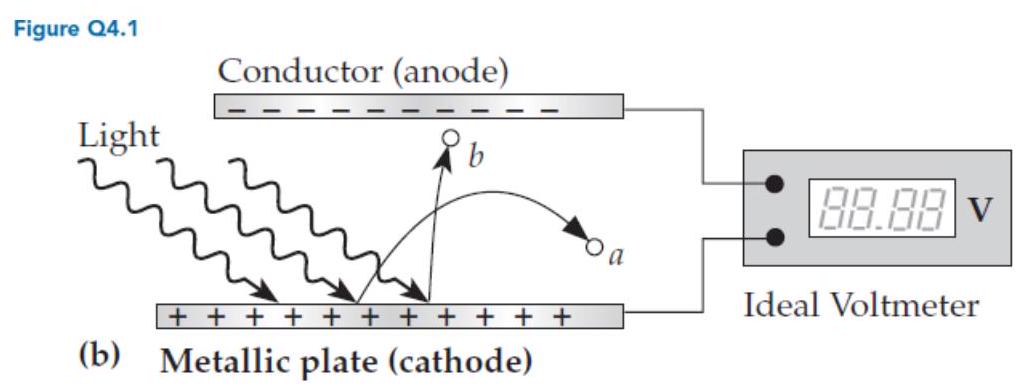
A) It immediately drops to zero.
B) It slowly decays to zero.
C) It remains fixed.
D) It does something else. (Describe what.)

A) It immediately drops to zero.
B) It slowly decays to zero.
C) It remains fixed.
D) It does something else. (Describe what.)

Unlock Deck
Unlock for access to all 210 flashcards in this deck.
Unlock Deck
k this deck
54
A beam of light has twice the wavelength but the same intensity as beam . The number of photons that hit a given area in a given time when it is illuminated by beam is (A) twice, (B) the same, or (C) one-half of the number that hit when the area is illuminated by beam ?
A) Twice}
B) The Same
C) One-half of the number that hit
A) Twice}
B) The Same
C) One-half of the number that hit

Unlock Deck
Unlock for access to all 210 flashcards in this deck.
Unlock Deck
k this deck
55
Though this would be tricky to do in practice, suppose we could increase the frequency of light illuminating the cathode of the apparatus shown in figure Q4.1a while holding the intensity of that light constant. What would Einstein's photon model predict would happen to the value displayed by the ammeter as the frequency increases? (Assume that the light's frequency is always above the cathode's cutoff frequency.)

A) It should increase.
B) It should remain the same.
C) It should decrease.
D) It might vary in a complicated way.

A) It should increase.
B) It should remain the same.
C) It should decrease.
D) It might vary in a complicated way.

Unlock Deck
Unlock for access to all 210 flashcards in this deck.
Unlock Deck
k this deck
56
The work function for copper is . Visible light will dislodge electrons from a copper surface.

Unlock Deck
Unlock for access to all 210 flashcards in this deck.
Unlock Deck
k this deck
57
If you want to design a phototube that is able to respond to all visible light wavelengths, what should its cathode's work function be?
A) Below
B) Any value between and
C) Some specific value between and
D) Above
E) Some other value or range (specify)
A) Below
B) Any value between and
C) Some specific value between and
D) Above
E) Some other value or range (specify)

Unlock Deck
Unlock for access to all 210 flashcards in this deck.
Unlock Deck
k this deck
58
If you want to design a phototube that ignores all visible light, what should its cathode's work function be?
A) Below
B) Any value between and
C) Some specific value between and
D) Above
E) Some other value or range (specify)
A) Below
B) Any value between and
C) Some specific value between and
D) Above
E) Some other value or range (specify)

Unlock Deck
Unlock for access to all 210 flashcards in this deck.
Unlock Deck
k this deck
59
Violet light with a wavelength of falls on a sodium plate and a potassium plate . Which of of the following statements is true?
A) Both plates emit electrons, but those emitted by the sodium plate have the larger kinetic energy.
B) Both plates emit electrons, but those emitted by the potassium plate have the larger kinetic energy.
C) Only the sodium plate emits electrons.
D) Only the potassium plate emits electrons.
E) Neither plate emits electrons.
A) Both plates emit electrons, but those emitted by the sodium plate have the larger kinetic energy.
B) Both plates emit electrons, but those emitted by the potassium plate have the larger kinetic energy.
C) Only the sodium plate emits electrons.
D) Only the potassium plate emits electrons.
E) Neither plate emits electrons.

Unlock Deck
Unlock for access to all 210 flashcards in this deck.
Unlock Deck
k this deck
60
A long-wavelength photon, because it is larger, carries more total energy than a short-wavelength photon.

Unlock Deck
Unlock for access to all 210 flashcards in this deck.
Unlock Deck
k this deck
61
Einstein's photon model is consistent with the results of two-slit interference experiments involving light.

Unlock Deck
Unlock for access to all 210 flashcards in this deck.
Unlock Deck
k this deck
62
Consider a beam of free particles with a certain speed . If we double this speed, what happens to the beam's de Broglie wavelength?
A) It increases by a factor of 2 .
B) It increases by a factor of .
C) It remains the same.
D) It decreases by a factor of .
E) It decreases by a factor of 2 .
A) It increases by a factor of 2 .
B) It increases by a factor of .
C) It remains the same.
D) It decreases by a factor of .
E) It decreases by a factor of 2 .

Unlock Deck
Unlock for access to all 210 flashcards in this deck.
Unlock Deck
k this deck
63
Consider a beam of free particles that each have a certain (nonrelativistic) kinetic energy . If we double this kinetic energy, what happens to the beam's wavelength?
A) It increases by a factor of 2 .
B) It increases by a factor of .
C) It remains the same.
D) It decreases by a factor of .
E) It decreases by a factor of 2.
A) It increases by a factor of 2 .
B) It increases by a factor of .
C) It remains the same.
D) It decreases by a factor of .
E) It decreases by a factor of 2.

Unlock Deck
Unlock for access to all 210 flashcards in this deck.
Unlock Deck
k this deck
64
Imagine that in a Davisson-Germer-type experiment we shine a beam of electrons on a nickel crystal perpendicular to the crystal face and find that we get enhanced scattering at an angle of . If we double the electrons' kinetic energy,
-(a) the angle of enhanced scattering will (A) increase, (B) decrease, or (C) remain constant,
-(a) the angle of enhanced scattering will (A) increase, (B) decrease, or (C) remain constant,

Unlock Deck
Unlock for access to all 210 flashcards in this deck.
Unlock Deck
k this deck
65
Imagine that in a Davisson-Germer-type experiment we shine a beam of electrons on a nickel crystal perpendicular to the crystal face and find that we get enhanced scattering at an angle of . If we double the electrons' kinetic energy,
-(b) by a factor (A) a bit larger than, (B) a bit less than, or (C) equal to
-(b) by a factor (A) a bit larger than, (B) a bit less than, or (C) equal to

Unlock Deck
Unlock for access to all 210 flashcards in this deck.
Unlock Deck
k this deck
66
Imagine that in a Davisson-Germer-type experiment we shine a beam of electrons on a nickel crystal perpendicular to the crystal face and find that we get enhanced scattering at an angle of . If we double the electrons' kinetic energy,
-(c) (A) 1 (B) , or (C) 2
-(c) (A) 1 (B) , or (C) 2

Unlock Deck
Unlock for access to all 210 flashcards in this deck.
Unlock Deck
k this deck
67
Imagine that we shine a beam of electrons with a de Broglie wavelength of through a pair of slits that have been miraculously constructed to be only apart. What will be the order of magnitude of the distance between bright spots of the interference pattern displayed on a fluorescent screen placed from the slits?
A)
B)
C)
D)
E)
A)
B)
C)
D)
E)

Unlock Deck
Unlock for access to all 210 flashcards in this deck.
Unlock Deck
k this deck
68
To create an interference pattern, a quanton beam's de Broglie wavelength must be larger than an individual quanton.

Unlock Deck
Unlock for access to all 210 flashcards in this deck.
Unlock Deck
k this deck
69
If the value of were bigger, it would be easier to display quanton interference effects.

Unlock Deck
Unlock for access to all 210 flashcards in this deck.
Unlock Deck
k this deck
70
Consider the experimental evidence we have discussed in the past few chapters. Classify the following experimental results according to the following scheme: For the quantons in question, the results:
- When light goes through a slit, the beam broadens somewhat, and if it is projected on a screen, one can see bright and dark fringes on the slit image.
- When light goes through a slit, the beam broadens somewhat, and if it is projected on a screen, one can see bright and dark fringes on the slit image.

Unlock Deck
Unlock for access to all 210 flashcards in this deck.
Unlock Deck
k this deck
71
Consider the experimental evidence we have discussed in the past few chapters. Classify the following experimental results according to the following scheme: For the quantons in question, the results:
- When light shines on a metal surface, electrons are ejected from the surface.
- When light shines on a metal surface, electrons are ejected from the surface.

Unlock Deck
Unlock for access to all 210 flashcards in this deck.
Unlock Deck
k this deck
72
Consider the experimental evidence we have discussed in the past few chapters. Classify the following experimental results according to the following scheme: For the quantons in question, the results:
- The number of electrons ejected from a metal surface depends directly on the intensity of the light shining on that metal surface.
- The number of electrons ejected from a metal surface depends directly on the intensity of the light shining on that metal surface.

Unlock Deck
Unlock for access to all 210 flashcards in this deck.
Unlock Deck
k this deck
73
Consider the experimental evidence we have discussed in the past few chapters. Classify the following experimental results according to the following scheme: For the quantons in question, the results:
-The maximum kinetic energy of electrons ejected from a metal surface depends on the frequency of the light shining on the surface, and not on the intensity.
-The maximum kinetic energy of electrons ejected from a metal surface depends on the frequency of the light shining on the surface, and not on the intensity.

Unlock Deck
Unlock for access to all 210 flashcards in this deck.
Unlock Deck
k this deck
74
Consider the experimental evidence we have discussed in the past few chapters. Classify the following experimental results according to the following scheme: For the quantons in question, the results:
-When light shines on a surface, at least a few electrons seem to get ejected virtually as soon as the surface is illuminated, even if the light is extremely dim.
-When light shines on a surface, at least a few electrons seem to get ejected virtually as soon as the surface is illuminated, even if the light is extremely dim.

Unlock Deck
Unlock for access to all 210 flashcards in this deck.
Unlock Deck
k this deck
75
Consider the experimental evidence we have discussed in the past few chapters. Classify the following experimental results according to the following scheme: For the quantons in question, the results:
-An electron beam shining on a nickel crystal is preferentially reflected in certain directions instead of being scattered uniformly in all directions.
-An electron beam shining on a nickel crystal is preferentially reflected in certain directions instead of being scattered uniformly in all directions.

Unlock Deck
Unlock for access to all 210 flashcards in this deck.
Unlock Deck
k this deck
76
Consider the experimental evidence we have discussed in the past few chapters. Classify the following experimental results according to the following scheme: For the quantons in question, the results:
-Light that goes through two narrow, closely spaced slits in an opaque barrier and then falls on a screen creates a pattern of multiple bright spots on the screen.
-Light that goes through two narrow, closely spaced slits in an opaque barrier and then falls on a screen creates a pattern of multiple bright spots on the screen.

Unlock Deck
Unlock for access to all 210 flashcards in this deck.
Unlock Deck
k this deck
77
Consider the experimental evidence we have discussed in the past few chapters. Classify the following experimental results according to the following scheme: For the quantons in question, the results:
- When dim light falls on a photomultiplier, the latter produces discrete electric pulses at random times.
- When dim light falls on a photomultiplier, the latter produces discrete electric pulses at random times.

Unlock Deck
Unlock for access to all 210 flashcards in this deck.
Unlock Deck
k this deck
78
Consider the experimental evidence we have discussed in the past few chapters. Classify the following experimental results according to the following scheme: For the quantons in question, the results:
-A rapidly moving electron leaves a track in a bubble chamber photograph.
-A rapidly moving electron leaves a track in a bubble chamber photograph.

Unlock Deck
Unlock for access to all 210 flashcards in this deck.
Unlock Deck
k this deck
79
Consider the experimental evidence we have discussed in the past few chapters. Classify the following experimental results according to the following scheme: For the quantons in question, the results:
- Photons sent one at a time through two slits appear individually to hit a detector array at random positions, but statistically fall into a two-slit interference pattern.
- Photons sent one at a time through two slits appear individually to hit a detector array at random positions, but statistically fall into a two-slit interference pattern.

Unlock Deck
Unlock for access to all 210 flashcards in this deck.
Unlock Deck
k this deck
80
Figure Q5.9 displays a sample simulated interference pattern for a quanton-at-a-time interference experiment (the graph shows the number of quanton detection events versus position) followed by five interference patterns labeled A through E. Each table row below describes a set of parameters that will create one of the displayed patterns (the first row shows the parameters that display the "Sample" pattern). The slit separation stated is a center-to-center distance. The table rows are organized so that each set of parameters differs from the previous one by a change in only one value. The "Detectors" column refers to whether there are proximity detectors operating at the slits. Your task is to write the appropriate letter in the table's right-most column. You might use some letters more than once. (Thanks to David Tanenbaum and Jason Evans for developing this exercise.)
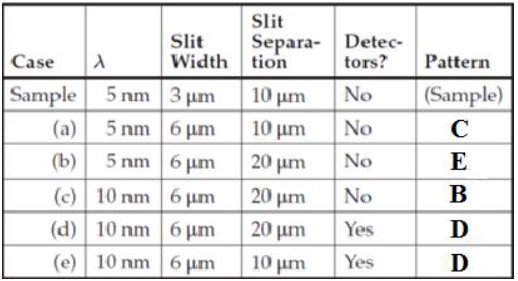

A.
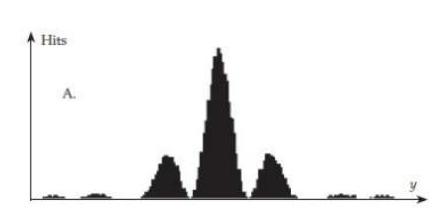
B.

C.
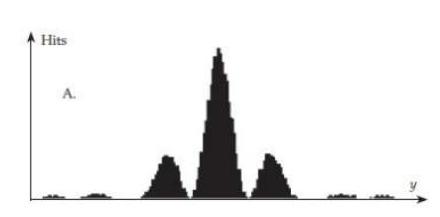
D.
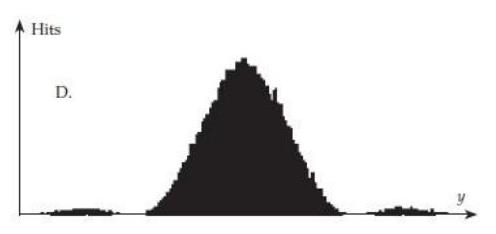
E.
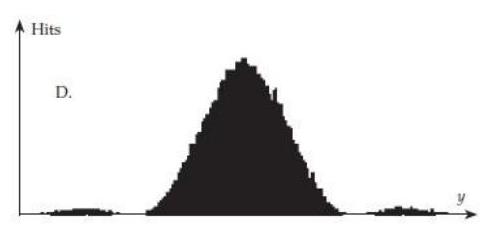


A.

B.

C.

D.

E.


Unlock Deck
Unlock for access to all 210 flashcards in this deck.
Unlock Deck
k this deck



